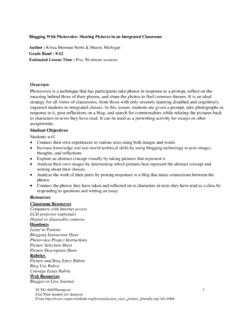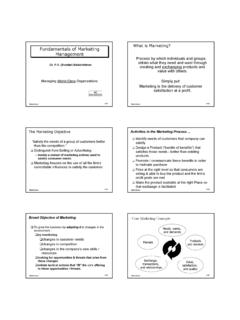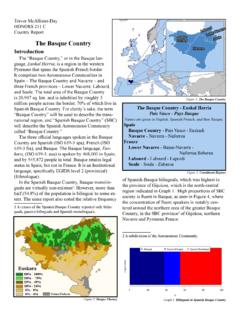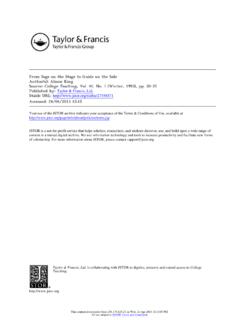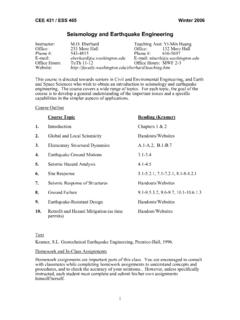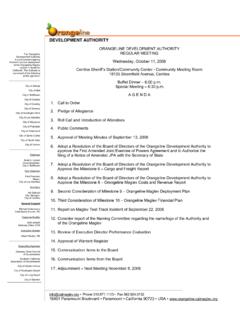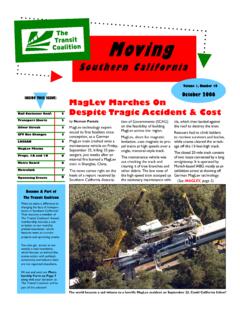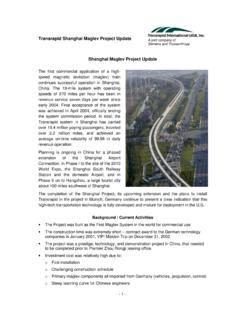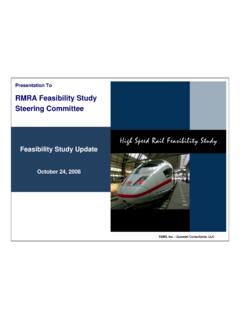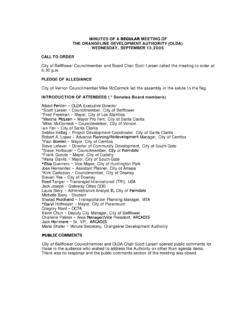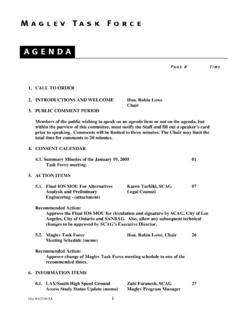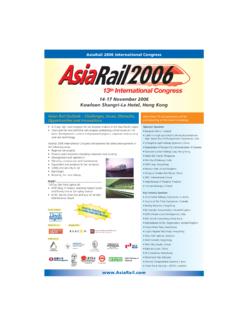Transcription of General Atomics Urban Maglev Program Status
1 1 INTRODUCTION This paper discusses the Status of the General Atom-ics Urban Maglev Program and the next steps in moving the project towards a demonstration system. Since the last report, the test track construction has been completed and significant testing accom-plished. The test track is full-scale, 120 meters in length, with a 50-meter radius curve. The track was completed in November 2004, and is shown with team members in Figure 1. Figure 1. Completed test track in San Diego, CA. The test vehicle consists of a single 5-meter chas-sis unit (a complete Urban vehicle is comprised of two 5-meter chassis units). The full-scale test chas-sis and its relation to a complete vehicle are shown in Figure 2. The levitation suspension system is of the Elec-troDynamic type, consisting of permanent magnets arranged in a Halbach Array configuration. The ba-sic magnetic system as well as the overall Program Status was discussed in a number of previous publi-cations [1]-[9].
2 A passive secondary suspension sys-tem provides damping and passenger ride quality. Propulsion and guidance are achieved with a perma-nent magnet Linear Synchronous Motor (LSM). Testing with chassis weight up to 10,000 kg, to a speed of 10 m/s, air gaps up to ~30 mm, and accel-eration up to m/s2 has been achieved (nominal acceleration is m/s2). The next steps in the pro-gram involve technology development needed to move the project towards a demonstration system. Figure 2. Full-scale chassis under-going dynamic testing, and its relation to a complete vehicle. On-going and planned activities include: control system optimization, hybrid girder testing, levita-tion/track system optimization, block switch and power pick-up testing, and vehicle body fabrication. The planned demonstration system is located at Cali-fornia University of Pennsylvania (CUP) in Califor-nia, Pennsylvania.
3 The demonstration system will provide the needed operational and reliability data prior to revenue system deployment. General Atomics Urban Maglev Program Status No. 99 Sam Gurol and Bob Baldi General Atomics , Electromagnetic Systems Division, Box 85608, San Diego, CA 92186-5608, USA Richard Post Lawrence Livermore National Laboratory, Box 808, L-644, Livermore, CA 94551, USA ABSTRACT: This paper discusses the Status of the General Atomics Urban Maglev project . The Status of the project was previously discussed at the Maglev 2004 conference in shanghai , China. Since that time, the test track construction has been completed and significant testing accomplished. The next steps in the project in moving towards a demonstration system will be discussed. 2 TECHNOLOGY DEVELOPMENT Near-Term Planned Activities Over the next several years, we plan to perform a number of tasks which will enable the project to transition from test track operations to construction of the demonstration system at CUP.
4 First priorities involve the refinement of the propulsion control sys-tem and completion of a detailed vehicle dynamics test Program . The on-going work related to the control system and associated position sensing for control of the LSM are discussed by Jeter, (paper no. 95, this conference). We are replacing the current optical position sensing equipment with a non-optical sys-tem, which enables all-weather operation, is not speed-limited, and results in more reliable operation since it is hard-wired to the control system. The propulsion control system is being modified to in-corporate this new position sensing, as well as being optimized to provide good ride quality, while fol-lowing the programmed speed profile. A detailed test Program will be undertaken once these changes are implemented to evaluate the vehicle dynamic be-havior. The control system works in tandem with the General Atomics built IGBT-based Variable Fre-quency Drive, shown in Figure 3, which is continu-ing to be tested for reliability, having undergone several modifications to improve thermal perform-ance for Urban Maglev system operation.
5 This sys-tem was developed for use on Urban and high speed Maglev , as well as for the Electromagnetic Aircraft Launch System (EMALS) for the Navy, and has been proven to be capable of reliable, high power operation over the last three years. Figure 3. General Atomics IGBT-based Urban Maglev inverter system. Other key technology development next steps in-volve the fabrication and testing of a second chassis (with articulation), vehicle car body, and a hybrid girder. The planned configuration for the first car body and its installation on the existing test chassis is seen in Figure 4. The body fabrication will enable verification of the modular construction approach, and development of a supplier base. Significant work has been performed to date re-lated to the use of a steel fiber-reinforced hybrid girder system. The results of this work are described in paper no.
6 97 of this conference (Venkatesh and Jeter). The basic girder system, with its attachments for the LSM and the levitation track is shown in Fig-ure 5. This system provides high strength and low cost for the demonstration system at CUP. Figure 4. Installation of car body on test chassis. Figure 5. Steel fiber reinforced hybrid girder system. Levitation System Optimization We are also evaluating a number of optimizations to the levitation system to improve its performance and efficiency in future revenue service. These range from optimizing the Halbach array configuration for maximum suspension stiffness to reducing the track construction cost (by using a simpler laminated track). A novel approach has been developed by Post [10] to improve both the suspension stiffness and the system efficiency (by reducing the drag power). BrakeEmbedmentLitz TrackSupport EmbedmentLSM MotorSupport EmbedmentLitz Track ClampInterface EmbedmentLitz TrackSupport EmbedmentLSM MotorSupport EmbedmentLitz Track ClampInterface Embedment Fairing Chassis Vehicle Body This approach involves the use of generator mag-nets on a small part of the track.
7 The modification is to append, on one or both ends of the levitation track, dual Halbach arrays configured in a genera-tor mode, as shown in Figure 6. The upper and lower arrays are phased with respect to each other so that their vertical field components add, while their horizontal field components cancel (or nearly cancel) in the gap between the two arrays. Figure 6. Dual Halbach Array in generator mode. The effect of appending these generator arrays to the normal Inductrack II dual array (as used on the test track) is to modify the amount of flux threading the circuit without appreciably changing the levita-tion force per ampere induced in the track conduc-tors. When two such arrays are appended, a new possibility exists, as follows: by shifting the phases of the vertical field component produced by the two arrays either flux enhancement (or cancellation) of the net inducing flux can be achieved.
8 For example, if the phase of one generator array is advanced by f radians, while that of the other is retarded by the same amount, then the net generator flux, Fg, will be varied in the manner given by equation 1. Fg[t]=F0 Cos[f]Cos[wt] (1) Thus by varying the phase angle f, it is possible to change the magnitude (and sign) of the flux through the track circuits in response to such pertur-bations as load changes. With rapid enough re-sponse, such a system could respond to gap changes associated with external perturbations, such as wind loads, etc. In the latter case it would be possible to correct for both pitch and roll motions of the train car. Another use of the above configuration would be to allow the stable use of biasing permanent magnets, attracted upward to iron plates on the track, to take up part of the levitation load. If such mag-nets can be used they can reduce the drag power losses by a large factor.
9 The concept here is to use the high stiffness of the Inductrack II Halbach array to maintain stability, and use the phase-shifted gen-erator arrays to control the operating point in an op-timum way. In a recent conceptual design study the drag power was shown to be reduced by more than a factor of two by this method. 3 CUP DEMONSTRATION SYSTEM Our test track design and testing are driven by on-going planning to construct a demonstration system. The test track will validate integrated levitation, pro-pulsion, and guidance. Upon successful completion of trials, the test track will continue being used for system optimization, while a demonstration system is constructed at California University of Pennsyl-vania (CUP) in California, Pennsylvania, located about 60 miles southwest of Pittsburgh. When com-pleted, this system will be km in length with four stations, and 3 vehicles, connecting the upper and lower campus via a 7% grade.
10 The system will serve the main campus, the city, and student hous-ing/sports facilities on the upper campus. Initially, it will be used to demonstrate the all weather, grade climbing, and ride quality capabilities of a Maglev system. An artist s rendition of the Maglev system connecting the upper and lower campuses is shown in Figure 7. Figure 7. The CUP demonstration system will demonstrate Maglev capabilities and serve a transportation need. The demonstration system construction is divided into three different phases, referred to as Projects 1, 2, and 3 respectively. Each project would by itself serve a transportation need on the campus. project 1 consists of ~700 m of elevated track, with a maxi-mum grade of 5 %, and two stations. To date, we have completed for project 1, the design of the align-ment, utility coordination, geotechnical sampling and testing, pier/caisson design, conceptual station design, and an environmental assessment (since Pro-ject 1 is constructed entirely on university land, it benefits from a categorical exclusion, and does not require a full environmental impact assessment).
